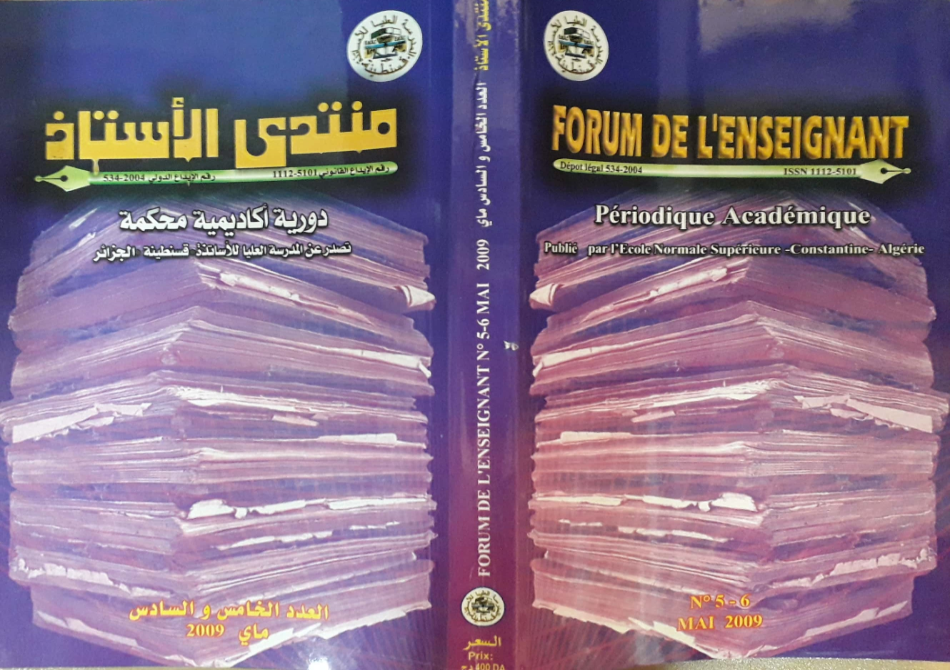Similarité organisationnelle parmi les membres du corps professoral des universités Le public jordanien et sa relation avec son sentiment de sécurité
Résumé
Le but de cette étude était d'examiner l'identification organisationnelle du personnel enseignant des universités publiques jordaniennes et sa relation avec leur sentiment de sécurité.
La population de l'étude était composée de l'ensemble des 2 905 professeurs jordaniens, nommés à temps plein dans les universités publiques jordaniennes. L'échantillon de l'étude (n. 582) a été sélectionné au hasard.
Deux instruments ont été développés pour la collecte de données ; le premier instrument, un portefeuille de répondants, est un OIQ qui a été conçu pour la première fois par Cheney (1982). Le second est un questionnaire sur l'instrument du sentiment de sécurité.
Les résultats de l'étude ont indiqué que le degré d'identification organisationnelle était élevé (3,97). Il a également indiqué que le sentiment de sécurité parmi les participants était également élevé (3,94).
Les résultats ont révélé une corrélation positive entre l'identification organisationnelle et le sentiment de sécurité (le coefficient de corrélation était de 0,829).
Téléchargements
Références
بدر، حامد أحمد(1403هـ)."الرضا الوظيفي لأعضاء هيئة التدريس والعاملين بكلية التجارة والاقتصاد والعلوم السياسية بجامعة الكويت"، مجلة العلوم الاجتماعية، العدد (3)، السنة الحادية عشرة، ص 61-36.
التويجري، محمد إبراهيم(1998). أهمية أولويات حاجات ماسلو للتدرج الهرمي للموظفين في الشركات والمؤسسات في المملكة العربية السعودية، المجلة العربية للإدارة، مجلد (13)، عدد (1)، المنظمة العربية للعلوم الإدارية، عمّان: الأردن، ص 58-85.
جابر، عبدالحميد جابر(1986). نظريات الشخصية. القاهرة: دار النهضة العربية.
حسين، محمود عطا (1987). مفهوم الذات وعلاقته بمستويات الطمأنينة الانفعالية، الكويت: مجلة العلوم الاجتماعية، المجلد (15)، العدد (3)، ص 103-128.
دواني، كمال، وديراني، عيد(1983). "اختبار ماسلو للشعور بالأمن، دراسة صدق للبيئة الأردنية"، مجلة دراسات، المجلد (10) العدد الثاني، ص47-56.
رشيد، مازن فارس(2003). الهويّة التنظيمية والتماثل التنظيمي: تحليل للمفهوم والأبعاد السلوكيّة لتطبيقاته، مركز البحوث بكلية العلوم الإدارية، جامعة الملك سعود، السعودية.
الرواشدة، خلف سليمان العبدالله(2005). "درجة مشاركة معلمي المدارس الثانوية العامة في الأردن في عملية صناعة القرار في مدارسهم وعلاقتها بشعورهم بالأمن وولائهم التنظيمي"، (أطروحة دكتوراه غير منشورة)، جامعة عمّان العربية للدراسات العليا: عمّان، الأردن.
الريحاني، سليمان(1985). أثر نمط التنشئة الأسرية في الشعور بالأمن، مجلة دراسات، المجلد (12)، العدد (11)، ص199-219.
الزغول، عماد عبدالرحيم(2002). مبادﺉ علم النفس التربوي، ط2، العين: دار الكتاب الجامعي.
السالم، مؤيد سعيد(2002). تنظيم المنظمات: دراسة في تطوير الفكر التنظيمي خلال مائة عام، ط1، إربد: دار عالم الكتاب الحديث.
السلمان، فؤاد مصطفى(1995). "درجة تحقق حاجة الإحساس بالأمن لدى أعضاء هيئة التدريس في الجامعات الأردنية"، (رسالة ماجستير غير منشورة)، الجامعة الأردنية، عمّان، الأردن.
الشرعة، حسين سالم(2000). "الأمن النفسي وعلاقته بوضوح الهوية المهنية"، مجلة مؤتة للبحوث والدراسات: سلسلة العلوم الإنسانية والاجتماعية، المجلد الخامس عشر، العدد الثالث، ص157-177.
الطيب، محمد عبدالظاهر، والدد، عبده السيد(2002). الصحة النفسية وعلم النفس الاجتماعي والتربية الصحية، مصر: جامعة طنطا.
عبدالسلام، فاروق(1978). القيم وعلاقتها بالأمن النفسي، كلية التربية، جامعة الملك عبدالعزيز، مكة المكرمة.
العتيبي، صبحي جبر(2005). تطور الفكر والأساليب في الإدارة، ط1، عمّان: دار الحامد للنشر والتوزيع.
العيسوي، عبدالرحمن(1985). سيكولوجية التنشئة الاجتماعية، الإسكندرية: دار الفكر الجامعي.
فارس، أحمد(1979). معجم مقاييس اللغة. بيروت: دار الفكر.
القرالة، أروى عبدالسلام(2005)."أثر المشاركة في بلورة التماثل التنظيمي"، (رسالة ماجستير غير منشورة)، جامعة مؤتة، الأردن.
كفافي، علاء الدين(1989). "تقدير الذات في علاقته بالتنشئة الوالدية والأمن النفسي، دراسة في علية تقدير الذات". المجلة العربية للعلوم الإنسانية، 9 (35)، ص100-127.
نشواني، عبدالمجيد(2003). علم النفس التربوي. عمّان: دار الفرقان للنشر والتوزيع.
هاشم، أحمد عمر(1986). الأمن في الإسلام، القاهرة: دار المنار للطبع والنشر.
وزارة التعليم العالي والبحث العلمي(2007). التقرير الإحصائي السنوي عن التعليم العالي في الأردن لعام 2006/2007م، مديرية الدراسات والتخطيط- قسم الإحصاء.
ثانياً: المراجع في اللغة الإنجليزية
Ashforth, B. E., & Mael, F. A. .(1989)."Social identity theory and the organization", Academy of Management Review, 14, p.20-39.
Cheney, George. (1982). “On the various and changing meanings of organizational membership: A field study of organizational identification”, Communication Monographs. 50: 342-362.
Duncan, J. E. .(2002)."Organizational Identification: An Insight in to Republic Bank and Trust", University of Kentucky, p. 1-17.
Elizur, Dov. .(1994). "Gender and Work Values: A comparative Analysis", Journal of Social Psychology, 134 (2), P.201-212.
Glynn, M. A. (1998).”Individuals’ need for organizational identification (nOID): Speculations on individual differences in the propensity to identify”, In D. A. Whetten & P. C. Godfrey (Eds.), Identity in Organizations: Building theory through conversations, P.238-244, Thousand Oaks, CA: Sage.
Hall, D. T., Schnider, R. B. & Nygren, H. T. .(1970). "Personal Factor of Organizational Identification", Administrative Science Quarterly, Vol.15, p. 176-190.
Hant, S. D. & Morgan, R. M. .(1994). "Organizational Commitment: One of Many Commitment or Key Mediating Construct", Academy of Management journal, Vol. 37, No. 6, p. 1568-1587.
Jeffry, T. P. .(2002). Explaining the Varying Effects of Organizational Identification on Cooperation: The Moderating Role of Subgroup Reputations", Working Papers, Harvard Business School, Morgan Hal, 333.
Johnson, W. L., & Johnson, A. M., & Heimberg, F. .(1999). "A Primary- and Second-Order Component Analysis of the Organizational Identification Questionnaire", Educational and Psychological Measurement, Vol. 59, No.1, P.159-170.
Knippenberg, Daan van, Schie, Els C. M. Van. (2000). “Foci and correlated of organizational identification”, Journal of Occupational and Organizational Psychology, 73, 137-147.
Maslow, A. (1970).”Motivation and personality. Harper and Row.NY.
Nelson, Natalie. (2002),” Reengineering Identity: A Case Study of Multiplicity and Duality in Organizational Identification”, Management Communication Quarterly, V.16 N.1, p5-38.
Puurula, Arja & Lofstrom, Erika .(2003). "Development of Professional Identity in SMEs". Paper Presented at the American Educational Research Association (AERA) "Accountability for Educational Quality: Shared Responsibility" (84th, Chicago, IL, April 21-25.2003.
Reitz, H. J. .(1981). Behavior in Organizations, (5ev. ed) Homewood, IL: Richard. D. IRWIN.
Ryff, C. & Keyes, C. (1995). “ The Structure of Psychological well-being Revisited”. Journal of Personality and Social Psychology, Vol. 69 (4): 719-727.
Tornyay, R. .(1996). "Dealing With Tenured Faculty", Educational Researches Information Center, Vol. 18.No. 2, P.38.





